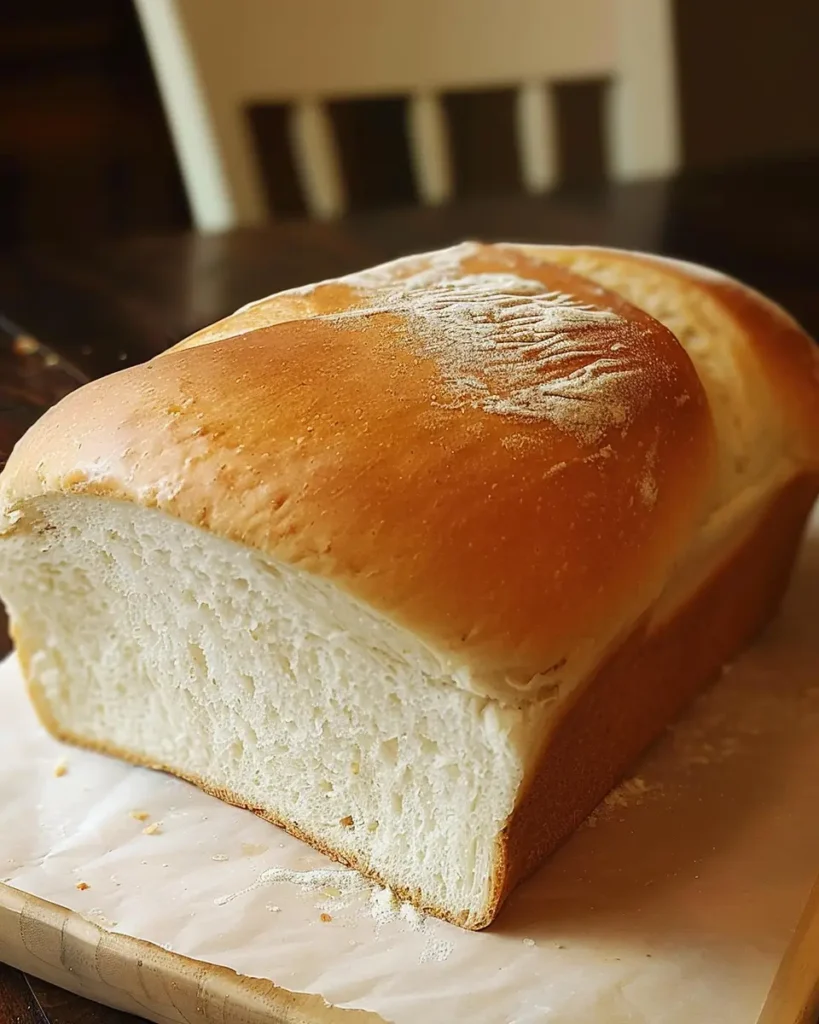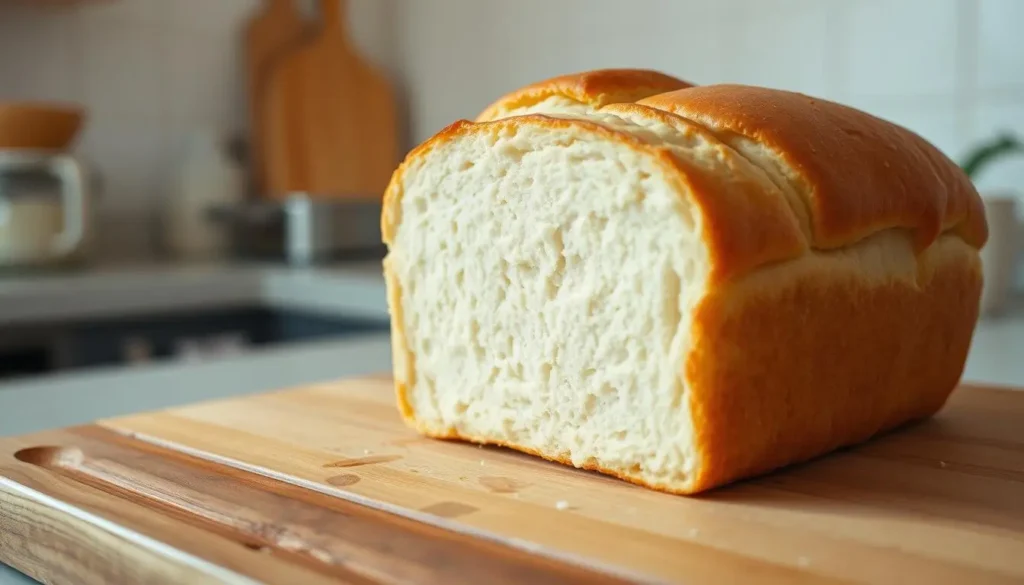Imagine the comforting aroma of fresh bread in your kitchen. It brings back memories of family gatherings and warm meals. Making your own bread is more than just a hobby; it’s a way to save money and create something special.
This thrifty homemade sandwich bread recipe lets you enjoy the process of making a delicious loaf. It’s perfect for any sandwich. Whether you’re new to baking or have years of experience, this guide will make your kitchen cozier and your meals heartier.

Key Takeaways
- Create budget-friendly homemade bread with simple ingredients.
- Thrifty techniques to save money while enjoying fresh bread.
- Suitable for all baking skill levels.
- Brings a sense of nostalgia and warmth to your kitchen.
- Perfect for daily meals and gatherings.
Introduction to Thrifty Homemade Sandwich Bread
Baking from scratch can turn your kitchen into a place of wonderful smells and tastes. In the cold winter, making homemade sandwich bread is a fun and budget-friendly activity. It fills your home with the scent of fresh bread and boosts your bread-making skills.
Picture the joy of baking a loaf yourself, perfect for sandwiches or as a side with soups and salads. This project is great for families, letting kids and adults work together. It’s a way to create something tasty and bond over shared moments.

With a little help, you can explore bread-making and find flavors you love. So, get ready to start this fun journey into making your own sandwich bread!
Benefits of Making Your Own Sandwich Bread
Making your own sandwich bread has many homemade bread benefits. It’s a great way to save money. A homemade loaf costs about $0.64, which is cheaper than most store-bought bread. This makes delicious bread affordable.
Another good thing is knowing what’s in your bread. You can skip preservatives and unhealthy stuff found in store bread. By choosing healthy bread alternatives, you can use whole grains, seeds, and natural sweeteners. This lets you make bread that fits your health goals.
Baking your own bread also brings joy. Seeing your dough turn into a golden loaf is very satisfying. It makes your meals better and adds happiness to the cooking process. Learn more about easy baking in this quick guide. Enjoy the simple pleasure of homemade bread and all its benefits!
Understanding Basic Homemade Bread Ingredients
Starting to make homemade bread is exciting. Knowing the basic ingredients is key. You’ll need flour, yeast, sugar, oil, salt, and water. Each one adds something special to your bread.
Flour is the main ingredient. You can use all-purpose flour or bread flour. Bread flour makes the bread chewier because it has more protein. Yeast makes the dough rise, giving it a light texture.
Sugar adds sweetness and helps the bread brown when it’s baked. Oil keeps the bread moist, making it soft. Salt brings out the flavors. Water helps the flour come together, making the dough elastic.
Thrifty Homemade Sandwich Bread Recipe and Instructions
Making your own sandwich bread at home is rewarding and saves money. With a simple budget-friendly bread recipe, you can have fresh, tasty bread without breaking the bank. Here’s a guide to making the perfect loaf.
Preparation Time: 10 minutes
Cooking Time: 30 minutes
Ingredients:
- 3 cups all-purpose flour
- 1 packet (2 ¼ teaspoons) of active dry yeast
- 1 teaspoon salt
- 2 tablespoons sugar
- 1 cup warm water (around 110°F)
- 2 tablespoons vegetable oil
Here’s how to make your ideal sandwich bread:
- Mix Ingredients: In a large bowl, mix warm water, sugar, and yeast. Wait 5 minutes for it to get frothy. Then, add salt, oil, and flour while stirring.
- Knead the Dough: Move the mix to a floured area. Knead for 8-10 minutes until it’s smooth and elastic.
- Prove the Dough: Put the dough in a greased bowl, cover it, and let it rise in a warm spot for 1 hour or until it doubles.
- Shape the Loaf: After rising, gently punch down the dough. Shape it into a loaf and put it in a greased loaf pan.
- Bake the Bread: Preheat your oven to 350°F. Cover the loaf with a cloth and let it rise for 30 minutes. Then, bake for 25-30 minutes until it’s golden.
After baking, let the bread cool on a wire rack before slicing. You can adjust the ingredients and measurements to change the bread’s texture and taste. Enjoy this sandwich bread recipe for many meals!
Essential Tools for Making Sandwich Bread
Baking homemade sandwich bread is easier with the right tools. It’s not just about the ingredients. You also need the proper kitchen tools. Here’s a list of must-have equipment:
- Mixing Bowl: A large mixing bowl is essential for combining your ingredients smoothly.
- Stand Mixer (or Hand Mixer): For those who prefer to knead their dough with ease, a stand mixer is a lifesaver, while a hand mixer is great for smaller batches.
- Measuring Cups: Accurate measurements are key. Invest in both dry and liquid measuring cups for precise results.
- Loaf Pan: A good-quality loaf pan ensures even baking and helps shape your bread perfectly.
- Kitchen Towel: This simple tool is key for covering your dough while it rises, keeping it warm and moist.
- Oven Thermometer: An often-overlooked tool, an oven thermometer guarantees that your baking environment is at the right temperature.
With these essentials, you’ll be ready to tackle bread-making with confidence. Each tool helps you make a soft, fluffy loaf. The right tools can make a big difference in your baking journey.
Pro Tips for Perfectly Shaped Loaf
Shaping sandwich bread is key in bread-making. How you handle the dough affects the loaf’s texture and rise. Start by gently punching down the dough to release air after the first proofing. This ensures your bread is evenly textured.
After punching down, it’s time for shaping. Divide the dough into equal parts for uniformity. Fold the dough over itself to create a tight surface, sealing edges as you go. This helps develop gluten, making the bread delightful to eat. Remember, handling the dough with care is vital.
When putting the dough in the loaf pan, make sure it fits well. Press down gently to remove air pockets, which can stop the dough from rising fully. For better bread shaping, try these techniques. For more tips, check out this quick and easy no-knead bread guide.
To sum up, here are some key points for shaping your loaf:
- Gently punch down the dough
- Divide the dough into equal portions
- Fold and seal to create tension
- Ensure a snug fit in the loaf pan
Different Methods for Proofing Bread Dough
Proofing dough is key in bread-making. It greatly affects the final taste and texture. There are many proofing methods to choose from, depending on your kitchen and tools. Knowing these homemade bread proofing techniques can really improve your bread.
The classic way is to put your dough in a warm, quiet place. This could be near a heater or a sunny window. For faster rising, a warm spot is vital. A warming drawer or a low oven works well too.
Modern tools offer easier options. An Instant Pot on the yogurt setting or a bread machine’s proof function can speed things up. These gadgets keep a steady temperature, perfect for dough.
Another method is using the stovetop. Boil water in a saucepan, then place a bowl covered with plastic wrap over it. This creates a warm, humid space for quick rising.
| Proofing Method | Best For | Time Required |
|---|---|---|
| Traditional Warm Spot | General use | 1-2 hours |
| Instant Pot/Yogurt Setting | Speeding up dough rising | 30-60 minutes |
| Oven with Low Heat | Humidity and warmth | 30-90 minutes |
| Stovetop with Steam | Humidity lovers | 1-2 hours |
Storing Your Homemade Bread Efficiently
Keeping your homemade sandwich bread fresh is key. The right bread storage tips can make a big difference. Choose a good storage solution like freezer bread bags or reusable bags for both short and long-term storage.
For short-term storage, place your bread in a cool, dry spot. A breadbox helps control moisture and keeps your loaf fresh. For longer storage, freeze it tightly wrapped to prevent freezer burn. This method helps you enjoy your bread for longer.
To keep your bread fresh, follow these tips:
- Slice only what you need to minimize exposure to air.
- Store bread in paper bags for short durations, as they allow for some ventilation.
- Avoid refrigerating bread, as this can speed up staling.
- When reheating, wrap the bread in foil to maintain moisture.
Using these bread storage tips will keep your bread fresh for days. Learn more about storing bread at this resource. With these tips and the right storage, you’ll be a pro at storing bread.
| Storage Method | Best For | Pros | Cons |
|---|---|---|---|
| Room Temperature (Breadbox) | Short-Term | Convenient, retains texture | Limited lifespan, prone to mold |
| Freezer Bags | Long-Term | Prevents freezer burn, versatile | Requires defrosting time |
| Parchment Paper | Short-Term (Sliced) | Allows air circulation, easy | Can dry out bread if left too long |
Smart storing bread efficiently methods ensure every bite is as good as the first. For more ideas and tips, check out this guide.
Variations of the Thrifty Homemade Sandwich Bread
Get creative with your baking by trying out different homemade bread variations. You can change the basic recipe to fit your taste or dietary needs. Adding herbs like rosemary or thyme gives a nice twist. Spices like garlic or onion powder add a strong flavor.
Looking for a healthier option? Try using whole grain flour. It boosts the fiber and adds a nutty taste. You can mix it with all-purpose flour for the perfect texture.
Want to make your sandwich bread special? Add seeds or nuts. Flaxseeds, sunflower seeds, or walnuts not only taste great but also make your bread healthier. You can sprinkle them on top before baking or mix them into the dough.
Try something new with quick bread recipes that don’t need yeast. They use buttermilk or baking soda for rising. They’re quick and perfect for those in a hurry.
| Variation | Main Ingredient | Flavor Profile |
|---|---|---|
| Herb Bread | Fresh basil, rosemary | Aromatic and savory |
| Whole Grain Bread | Whole wheat flour | Nuts and earthy |
| Seed Bread | Flaxseeds, sunflower seeds | Crunchy and nutritious |
| Quick Bread | Buttermilk | Rich and tangy |
Trying out these variations lets you enjoy different tastes and textures in your homemade sandwich bread. Making your bread your way not only pleases your taste buds but also makes every meal special.
Why Choose Homemade Sandwich Bread?
Choosing homemade sandwich bread has many advantages of homemade bread. You get to pick the ingredients, avoiding additives and preservatives found in store-bought bread. This lets you make bread that fits your dietary needs, like gluten-free or egg-free.
Another great reason is the cost savings. Making your own bread can be cheaper. You can buy ingredients in bulk and bake more at once. This cuts down on grocery bills and adds to the fun of baking.
Homemade bread making is rewarding. It turns baking into a fun activity, not a chore. You can play with flavors and enjoy the process. Plus, the smell of fresh bread in your home is a wonderful bonus.
In short, choosing homemade bread is more than just a convenience. It’s about enjoying the flavors, saving money, and making it your own. For more on the joys of baking, check out this resource: baking bread worth it.
Conclusion
Making your own sandwich bread has many perks, like saving money and enjoying the process. You can pick the ingredients and tools that fit your taste. The tips and recipes in this article will help you on your baking journey.
Starting to make your own bread is exciting. You can try different recipes and techniques. There’s nothing like biting into a warm slice of bread right from the oven.
This is your chance to become part of a community of proud bakers. Share your stories, exchange tips, and motivate others. With a little practice, you’ll soon be a pro at making delicious sandwich bread!
FAQ
What are the essential ingredients for making thrifty homemade sandwich bread?
You’ll need flour, yeast, sugar, oil, salt, and water. Each ingredient is key to making tasty sandwich bread.
How much does it cost to make homemade sandwich bread compared to store-bought?
Homemade sandwich bread costs about
FAQ
What are the essential ingredients for making thrifty homemade sandwich bread?
You’ll need flour, yeast, sugar, oil, salt, and water. Each ingredient is key to making tasty sandwich bread.
How much does it cost to make homemade sandwich bread compared to store-bought?
Homemade sandwich bread costs about $0.64 per loaf. This is much cheaper than many store-bought options.
Can I make sandwich bread without yeast?
Yes! You can make sandwich bread without yeast. Use baking powder or soda for leavening instead.
Is it suitable for beginners to make homemade sandwich bread?
Absolutely! The recipe is simple and welcoming for all, from beginners to experienced bakers.
How can I customize my homemade sandwich bread recipe?
Add herbs, spices, seeds, nuts, or whole grains to enhance flavor and nutrition. This way, you can make a loaf that’s uniquely yours.
What are the best methods for proofing bread dough?
Traditional methods involve a warm area. Modern methods include using an Instant Pot or warming center. Choose based on your kitchen.
How should I store my homemade sandwich bread to keep it fresh?
Store in freezer bread bags or reusable bags. Sealing the bread helps prevent it from drying out or becoming stale.
Can I make bread without eggs?
Yes, this homemade bread no egg option is great for those avoiding eggs. It’s perfect for various dietary needs.
What tools do I need for making homemade sandwich bread?
You’ll need a mixing bowl, stand mixer or hand mixer, measuring cups, a loaf pan, and a kitchen towel for covering the dough.
Why is homemade sandwich bread better than store-bought?
Making your own bread lets you control the ingredients and save money. You also get to enjoy the process and meet specific dietary needs easily.
.64 per loaf. This is much cheaper than many store-bought options.
Can I make sandwich bread without yeast?
Yes! You can make sandwich bread without yeast. Use baking powder or soda for leavening instead.
Is it suitable for beginners to make homemade sandwich bread?
Absolutely! The recipe is simple and welcoming for all, from beginners to experienced bakers.
How can I customize my homemade sandwich bread recipe?
Add herbs, spices, seeds, nuts, or whole grains to enhance flavor and nutrition. This way, you can make a loaf that’s uniquely yours.
What are the best methods for proofing bread dough?
Traditional methods involve a warm area. Modern methods include using an Instant Pot or warming center. Choose based on your kitchen.
How should I store my homemade sandwich bread to keep it fresh?
Store in freezer bread bags or reusable bags. Sealing the bread helps prevent it from drying out or becoming stale.
Can I make bread without eggs?
Yes, this homemade bread no egg option is great for those avoiding eggs. It’s perfect for various dietary needs.
What tools do I need for making homemade sandwich bread?
You’ll need a mixing bowl, stand mixer or hand mixer, measuring cups, a loaf pan, and a kitchen towel for covering the dough.
Why is homemade sandwich bread better than store-bought?
Making your own bread lets you control the ingredients and save money. You also get to enjoy the process and meet specific dietary needs easily.

Sandwich Bread
Ingredients
Bread Ingredients
- 3 cups all-purpose flour Can substitute with bread flour for a chewier texture.
- 1 packet active dry yeast (2 ¼ teaspoons) Helps the dough rise.
- 1 teaspoon salt Enhances the flavor of the bread.
- 2 tablespoons sugar Adds sweetness and helps with browning.
- 1 cup warm water (around 110°F) Activates the yeast.
- 2 tablespoons vegetable oil Keeps the bread moist.
Instructions
Preparation
- In a large bowl, mix warm water, sugar, and yeast. Wait 5 minutes for it to get frothy.
- Add salt, oil, and flour while stirring until well mixed.
- Transfer the mixture to a floured surface and knead for 8-10 minutes until smooth and elastic.
- Place the dough in a greased bowl, cover it, and let it rise in a warm spot for 1 hour or until it doubles in size.
- After rising, gently punch down the dough and shape it into a loaf.
- Put the shaped dough in a greased loaf pan.
- Cover the loaf with a cloth and let it rise for 30 minutes.
- Preheat your oven to 350°F (175°C) and bake for 25-30 minutes until golden.
- Let the bread cool on a wire rack before slicing.







